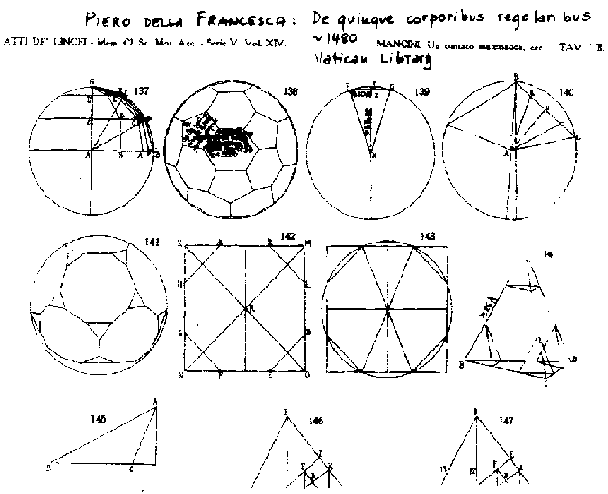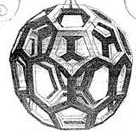History of the truncated icosahedron
Archimedes is believed to have conceived the thirteen "Archimedean solids",
among which the
truncated icosahedron is found.
To find out more about Archimedes and the Archimedean solids
This is oldest known picture of a truncated icosahedron (the shape of
C60. It is from the book Libellus de quinque
corpibus regularibus ("On the Five Regular Bodies"), by the Italian
renaissance painter and mathematician Piero della Francesca.

A copy of the
volume can be found in the Vatican library.

Leonardo da Vinci (1452-1519)
This rendition of the truncated icosahedron is from the book De Divina
Proportione ("On Divine Proportion") by Fra' Luca Pacioli, published
around 1498. The drawing is ascribed to Leonardo da Vinci. He seems to have
invented this type of "skeleton model", which lets us view both the outside
and the inside of the polyhedron.
The concept of truncating a polyhedron was introduced by Johannes Kepler.
Polyhedra were actually quite central to his research.
In his work Prodromus Dissertationum Mathematicarum Continens Mysterium
Cosmographicum ("The Cosmographic Mystery") he argued that the
distances of the planets from the sun were determined by the Platonic
solids. (see e.g. his
Biography
from the Galileo Project
at Rice University)

An example of the appearance of the truncated icosahedron in art is shown in
this picture from an Italian cathedral. At the top we see an icosahedron. It
is bounded by twenty equilateral triangles. At each of the 12 vertices of the
icosahedron, five of the triangles meet. Cutting off ('truncating') these
vertices thus replaces each of them by a pentagonal face; it also converts
each of the twenty former triangular faces into a hexagon. We can see the
resulting truncated icosahedron at the bottom of the picture. This is the
shape of the C60 molecule.
To get a glimpse of the treasures housed in the Vatican library, take a look
at the exhibit Rome
Reborn: The Vatican Library & Renaissance Culture at the
Library of Congress in Washington.
Especially the
page on mathematics
shows many works by Euclid, Archimedes, Pierro della Francesca, and many others.
Biographies
You can find the biographies of many mathematicians on the
History of
Mathematics site at the University of St Andrews, e.g.



